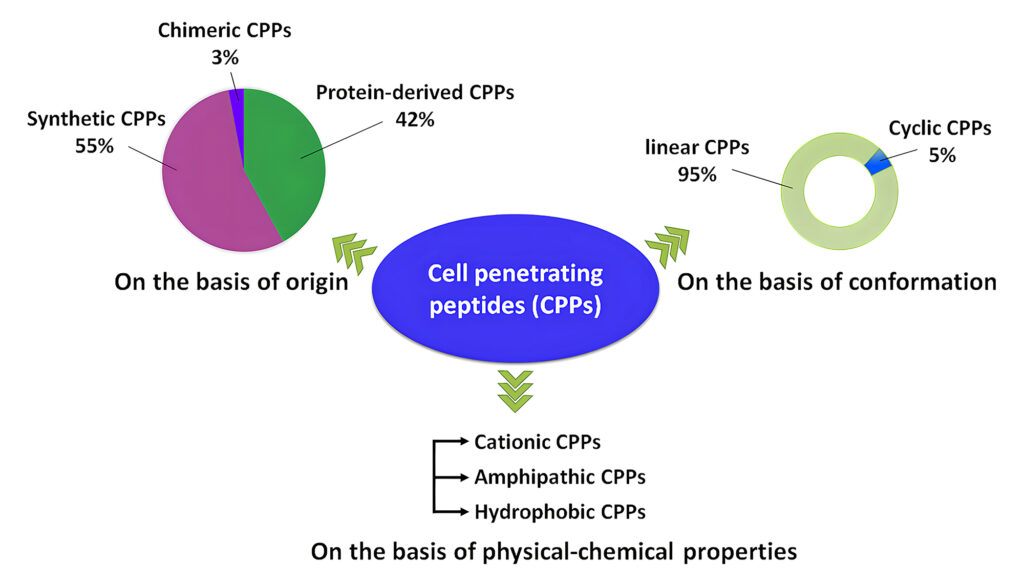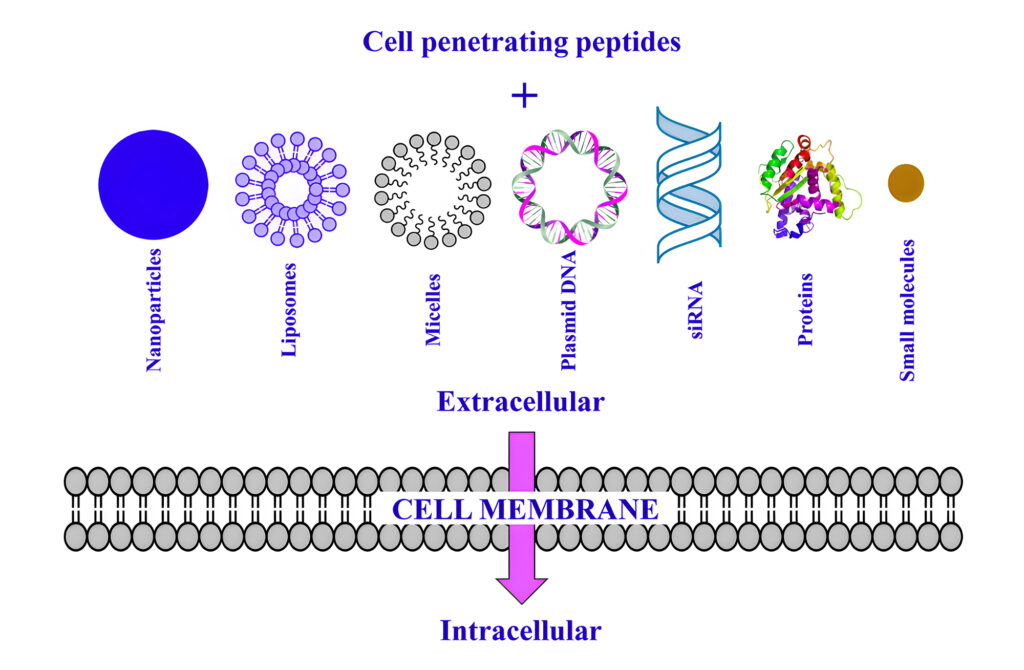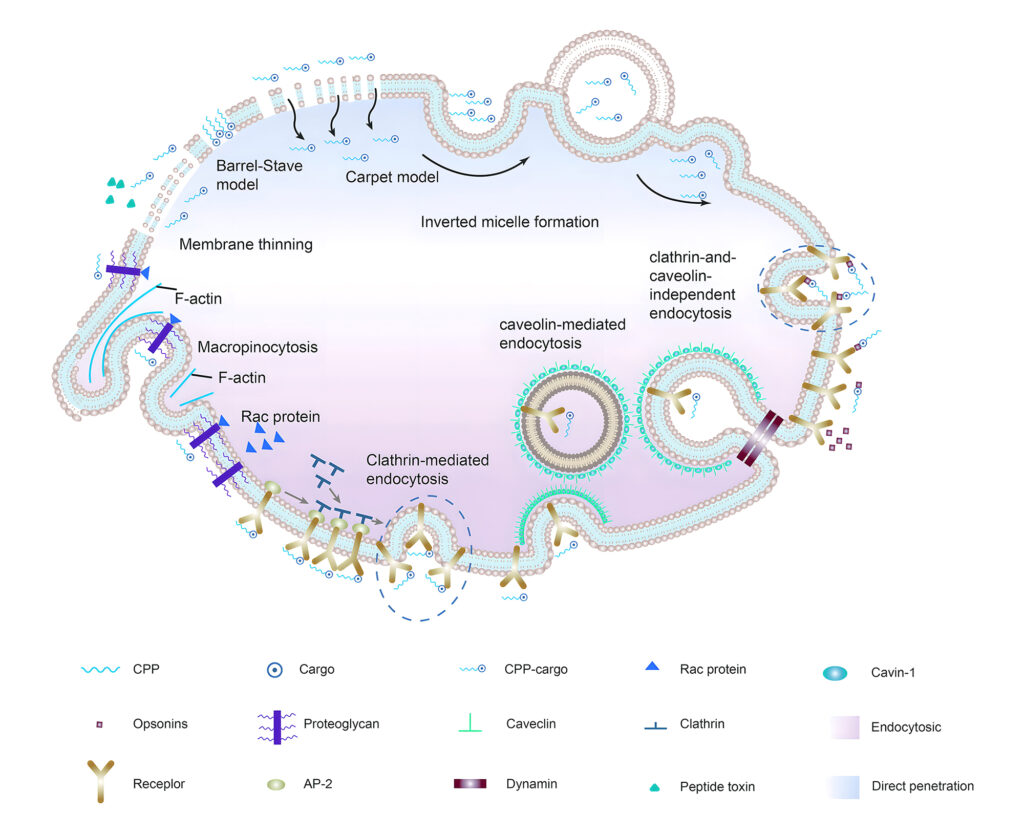Cell Penetrating Peptide
Cell Penetrating Peptides (CPPs), also known as Protein Transduction Domains (PTDs)
Cell Penetrating Peptides (CPPs), also known as Protein Transduction Domains (PTDs), are positively charged short peptides that consist of less than 40 amino acids. They can cross the cell membrane, delivering various compounds, such as siRNA, nucleic acid, small molecule, protein and cytotoxic drugs, carrying them into cells in the process. A vast majority of biologically active molecules must enter cells to exert their function. CPPs have been successfully applied in the delivery of different types of drugs, nanoparticles, and liposomes for disease diagnosis and treatment.
Many computational resources have been developed by researchers to provide information on CPPs. The freely accessible database of CPPsite 2.0 provides knowledge about CPPs and CPP resources, which mainly includes the following information: peptide sequence, nature of the peptide, chemical modifications, experimental validation techniques, structure of the peptide and types of cargo delivered.
Classification of CPPs
CPPs(cell penetrable peptides) have diversity in physicochemical and biological properties, different types of CPP have different length, charge, solubility, and hydrophobicity. Normally, CPP is classified according to different characteristics, like origin, conformation, physical and chemical properties.

Origin Based Classification
Based on their origins, CPPs are classified as: chimeric peptides, protein-derived peptides and synthetic peptides.
Conformation Based Classification
According to their conformation, CPPs are divided into linear and cyclic CPPs. Many current studies have confirmed that cyclic CPPs have higher cell permeability and higher affinity with the target receptor on the cell and higher resistance to proteolysis.
Physical–Chemical Character Based Classification
Depend on their physical and chemical properties, CPPs are classified into three subgroups: cationic CPPs, amphipathic CPPs, and hydrophobic CPPs.
Synthesis of Cell Penetrating Peptides
When cell penetrating sequences are added to the peptide cargo itself, we apply for the synthesis of the entire molecule in general either SPPS synthesis, or alternatively use chemical ligation strategies. When the cargo peptide are larger than 50 amino acids in length, chemical ligation strategies are preferred.

Ligation Strategies
Ligation approachs involve synthesis of the cargo peptide and CPP independently, as well as the introduction of suitable chemical handles at certain places during peptide synthesis. Because ligation merely requires the molecules to have a functional group appropriate for ligation, it allows for the conjugation of CPPs and non-peptide cargo molecules, which broadens the possible research opportunities and applications.
Ligation strategies can synthesize CPPs, including:
- Oxime ligation
- Thiol-maleimide coupling
- Click chemistry
- Isothiocyanate ligation
- NHS coupling
- Native Chemical Ligation (NCL)
Qyaobio is an experienced company which has supplied a variety of CPPs over years. By including unique or non-natural amino acids, peptide branching, and other alterations, we improve favorable characteristics of CPPs and enhance the performance of CPPs in their application. We ensure that the CPPs we produce has good solubilities, no aggregation risk, and high yields.
Design of specific CPPs
A limitation of most of the CPPs is their lack of cell or tissue selectivity, which limits their use in clinical development. To address this issue, three different general controlled delivery strategies have been proposed and developed.

- In the first strategy, designing cell and tissue specific CPPs. Phage display has been a technique widely used to isolate target-specific CPPs. RGD (Arg-Gly-Asp) and NGR (Asn-Gly-Arg) are two examples of such peptides with high specificity and strong affinity for a given target;
- In the second strategy, conjugation of CPPs with targeting moieties. CPPs are conjugated to various cell-specific targeting ligands via covalent or noncovalent bonds to generate targetable CPPs, such as folic acid, transferrin, RGD peptides, and antibodies;
- In the third and main strategy, modulation of CPP uptake by a stimulus-sensitive signal have been suggested and developed to control the delivery of CPP-cargo only at the target site. In this strategy, pH has been the most common condition triggering CPP activation at the target site, and pH-responsive peptides have been widely used to deliver therapeutic agents at the tumor site.
Building specificity into tumor targeting CPP constructs.
- Enzyme activatable CPP constructs
- pH-activatable constructs including CPPs
- Hypoxia-responding CPP fusion constructs
- Phage display technology
Custom Cell Penetrating Peptide
Qyaobio has rich experience in synthesizing a variety of commonly used CPPs, and also provides special CPPs composed of uncommon or unnatural amino acids. With Qyaobio, you can rely on comprehensive expertise in peptide chemistry and a wide range of modifications to design and synthesize CPPs.
Call Us
+86(021)-50795728
+86(027)-60707970
